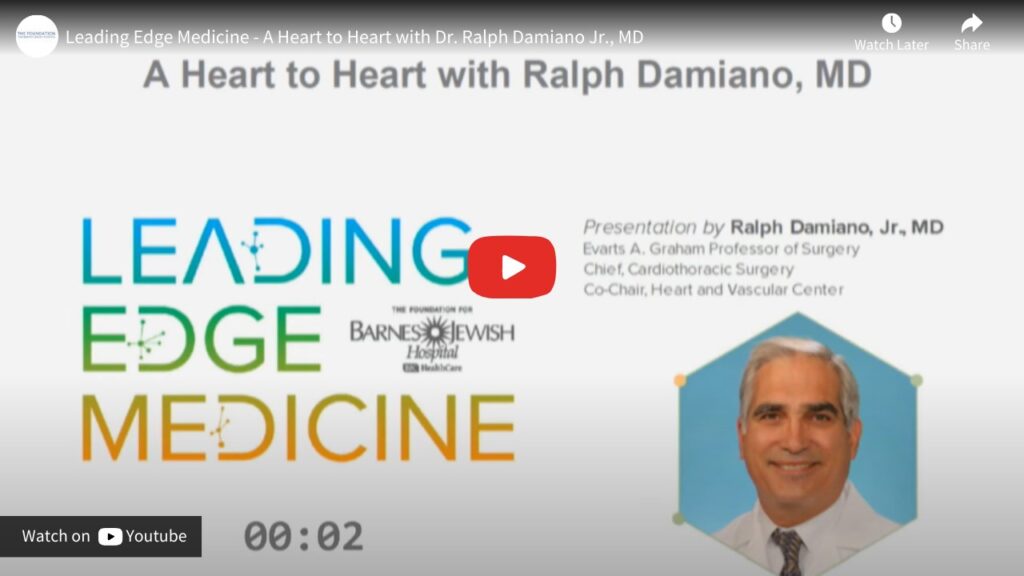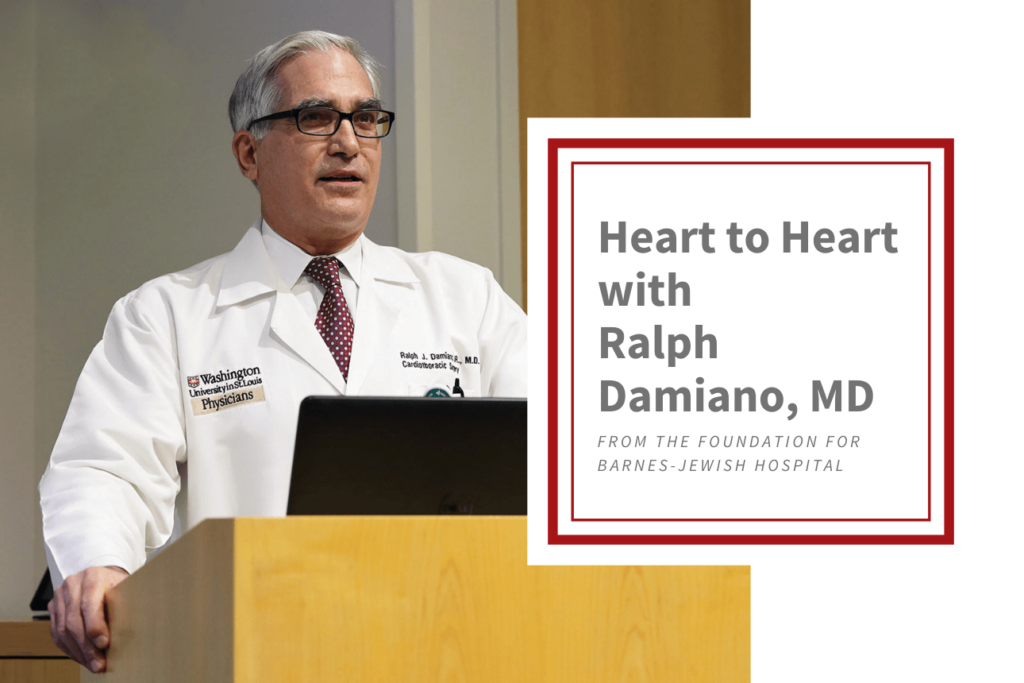This February, at the first virtual event in the Leading Edge Medicine series from the Foundation for Barnes-Jewish Hospital, Chief of Cardiothoracic Surgery Ralph Damanio, Jr., MD, shared some of the life-saving advances cardiothoracic surgeons and researchers at Washington University School of Medicine in St. Louis have made in lung transplant and heart surgeries. The Leading Edge Medicine series offers the Foundation’s most loyal donors an insider’s look at how their contributions are making an impact to improve lives.
The Division of Cardiothoracic Surgery at Washington University School of Medicine has a three-part mission: to provide high quality, world class clinical care; perform basic and clinical research to advance the field; and train and educate the next generation of cardiothoracic surgeons.
“The Foundation for Barnes-Jewish Hospital has provided critical support to allow us to achieve excellence in each of the three pillars of our academic mission,” Damiano, the Evarts A. Graham Professor of Surgery, said.
This support has led to major advances in the surgical treatment of cardiac arrhythmia, including the first cure for atrial fibrillation: the Cox-Maze procedure. Atrial fibrillation is the most common form of cardiac arrhythmia. Atrial fibrillation significantly increases a person’s risk of stroke, and drug therapy has been shown to be ineffective in most patients.
The Cardiac Surgery Arrhythmia Laboratory was founded in 1983 by James Cox, MD, the “father of cardiac arrhythmia surgery” and recipient of the Jacobson Innovation Award from the American College of Surgeons, to address the unpredictable effects of medical treatments for arrhythmia and the need to better understand the mechanisms in order to cure life-threatening rhythm disturbances. Richard Schuessler, PhD, served as the laboratory’s director until 2020. As current Director of the Cardiac Surgical Research Laboratory, Christian Zemlin, PhD, continues National Institutes of Health (NIH) funded atrial fibrillation research and enables the division to establish a strong relationship with the Biomedical Engineering School of Washington University by offering biomedical engineering students a defined program in the laboratory.
“Basic and translational research are the foundation for clinical innovation and progress,” says Damiano, the Co-Chair of the Washington University and Barnes-Jewish Heart and Vascular Center. “The surgeon-scientist plays a critical role by identifying clinical problems, researching the underlying mechanisms of disease processes and using this knowledge to develop improved therapeutics.”
The division is home to excellent surgeon-scientists and has been recognized as a world leader in lung transplantation for more than 30 years. At the Leading Edge Medicine virtual event, Damiano presented recent research from the Transplant Immunology Laboratory, including studies of pulmonary graft dysfunction, chronic lung allograft dysfunction, antibody mediated rejection and the impact of viral and bacterial lung infection.
The lung transplant program at the School of Medicine is led by Surgical Director of Lung Transplantation Daniel Kreisel, MD, PhD, the G. Alexander Patterson, MD/Mid-America Transplant Endowed Distinguished Chair in Lung Transplantation. Kreisel is principal investigator of two grants from the National Institutes of Health totaling $10 million to study the prevention of organ rejection after transplantation. He and Andrew Gelman, PhD, the Jacqueline G. and William E. Maritz Professor of Surgery, Pathology and Immunology, received one of the largest NIH program project grants to study lung allograft rejection.
The division trains cardiothoracic surgeons in one of the oldest and most active fellowship programs, led by Program Director Spencer Melby, MD. The division now offers a Congenital Cardiac Surgery Fellowship accredited by the American Council of General Medical Education (ACGME). The fellowship, led by Program Director and Pediatric Cardiothoracic Surgery Section Chief Pirooz Eghtesady, MD, PhD, is one of just 11 such programs in the country.
“It has been a primary objective of our division to train cardiothoracic surgeons, and in particular to develop them for future leadership,” Damiano says. “An integral part component of our training is to prepare surgeons to be physician-scientists.”
The division has also been awarded an NIH T32 Training Grant to train physician-scientists in cardiothoracic surgery.
“The grant has been funded for 25 consecutive years, making it both the oldest and largest of its kind in the country,” says Damiano. “We have trained more physician-scientists than any other program in the country. We have also trained 120 foreign fellows from 20 countries, and many have become leaders in their home countries.”
Over the last 90 years, the division has performed many firsts in cardiothoracic surgery, including the first successful pneumonectomy, the first successful surgical treatment of atrial fibrillation and the first successful lung volume reduction procedure. The division has been home to 13 presidents of the American Association for Thoracic Surgery (AATS) and the Society of Thoracic Surgeons, including current AATS President Marc Moon, MD.
Damiano concluded the event with a vision for the future of cardiothoracic surgery. He anticipates that the field will become more diverse, and that surgeon-scientists in the division will pioneer advances in patient care for years to come. For the first time, more women than men are training in cardiothoracic surgery at the School of Medicine. Washington University thoracic surgeons are leading in minimally invasive and robotic surgery at Barnes-Jewish Hospital and Christian Hospital. Research into new surgical techniques, the body’s inflammatory response to surgery and improved therapeutics are among the many innovative studies cardiothoracic surgeons are pursuing to improve patient care.
“We are extremely grateful to the Foundation and philanthropists for their support over the years in helping us to continually improve patient care and advance the field of cardiothoracic surgery,” Damiano says.

